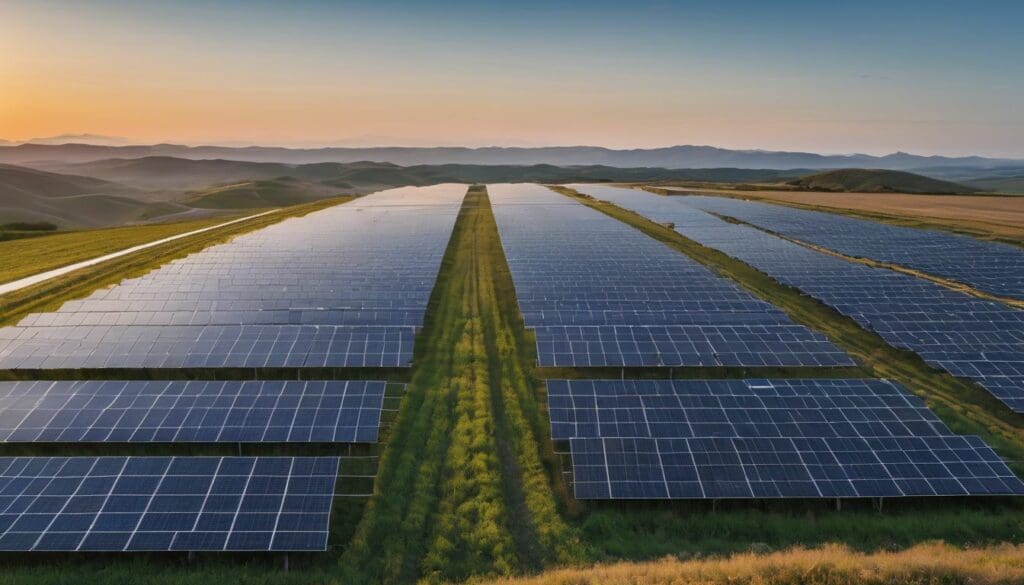Power cuts and high bills can leave us all in the dark. Solar energy has been lighting up our lives since the 1800s. We’re exploring how today’s solar panels became so advanced, they save more energy and money than ever before.
Stay bright; let’s dive in!
Key Takeaways
- Solar panel technology has surged since the 1800s, with significant milestones including Edmond Becquerel’s discovery of the photovoltaic effect in 1839 and Bell Labs’ creation of the first practical solar cell in 1954.
- Advancements have brought about bifacial solar panels, smart inverters, tracking systems for increased energy generation, and AI software for system performance monitoring.
- Costs have dropped dramatically from over $100 per watt in the 1970s to below $1 per watt by the 2010s due to technological improvements and economies of scale.
- Battery storage options like lithium – ion batteries facilitate energy use at night or during low sunlight, enhancing solar power’s viability as a consistent energy source.
- Government policies and incentives across various countries are crucial for fostering continued growth and adoption of solar technologies.
The History of Solar Energy
Solar energy has been used for thousands of years, dating back to ancient civilizations harnessing the power of the sun for heating and cooking. However, it wasn’t until the 19th century that solar panels were invented, leading to major advancements in the history of solar energy.
When was solar energy first used?
Humans harnessed the sun’s rays for warmth and to dry meats and grains as far back as ancient times. Think of the impressive sun temples built by the Egyptians, or Greek homes designed to maximise sunlight in winter.
But it wasn’t until 1839 that French physicist Edmond Becquerel discovered the photovoltaic effect, which allows for converting sunlight directly into electricity. This marked solar energy’s leap from passive heating to active power generation.
Following this breakthrough, scientists continued to explore how light could be turned into electric current. Innovations in solar technology marched on through the years, leading to Charles Fritts creating the first true solar cell made from selenium in 1883.
Although this early model boasted a mere one percent efficiency, it laid crucial groundwork for later developments in photovoltaic cells and renewable energy as we know today’s clean and sustainable technology.
When were solar panels invented?
In the late 19th century, the invention of solar panels marked a significant milestone in harnessing solar energy. In 1954, scientists at Bell Laboratories developed the first practical photovoltaic cell using silicon, paving the way for modern solar panel technology.
This pivotal moment laid the foundation for advancements in construction and materials that have since revolutionised the efficiency and cost-effectiveness of solar panels.
The innovation continues as new components and features are integrated into solar panel systems, such as solar charge controllers and battery storage options. The evolution of photovoltaics has led to increased adoption worldwide while driving progress towards sustainable clean energy sources.
Major events in the history of solar energy
The history of solar energy is filled with major events that have shaped its evolution. From the discovery of the photovoltaic effect in 1839 to the invention of the first solar cell in 1954, key milestones have accelerated the development of solar technology. The following events have significantly impacted the progress of solar energy:
- Discovery of the photovoltaic effect by Becquerel in 1839, which laid the foundation for solar cell technology.
- Invention of the first modern solar cell by Bell Labs in 1954 using silicon as a semiconductor material.
- Launch of Vanguard I, the first satellite to use solar cells for power generation, in 1958, marking a pivotal moment for space applications of solar energy technology.
- Establishment of the Solar Energy Research Institute (SERI) in 1977 – now known as NREL, which has been instrumental in advancing research and development within the field.
- Introduction of feed – in tariffs and net metering policies by countries such as Germany and Japan during the early 2000s, incentivising widespread adoption of solar panels.
Evolution of Solar Panel Technology
Solar panel technology has come a long way since the early days of concentrating sunlight. From the invention and adoption of solar panels to advances in construction and materials, the evolution of solar panel technology has been remarkable.
The early days: Concentrating sunlight
Harnessing the power of sunlight began in ancient times when civilizations used magnifying glasses to concentrate the sun’s rays for starting fires. This concept laid the foundation for early solar technologies, focusing sunlight to produce heat for various purposes.
In recent years, modern concentrating solar power (CSP) systems have further developed this principle, utilising mirrors or lenses to redirect and intensify sunlight onto a small area where it heats a fluid that drives a steam turbine, generating electricity.
Early attempts at concentrating sunlight laid the groundwork for contemporary CSP systems, which continue to advance and play a crucial role in sustainable energy generation today.
Invention and adoption of solar panels
The invention and adoption of solar panels revolutionised the harnessing of renewable energy. Solar panels were first developed in the 1950s, when photovoltaic technology was introduced to convert sunlight into electricity.
This innovation marked a turning point in renewable energy history, allowing for the widespread use of solar power as a sustainable alternative to traditional fossil fuels. The growing demand for clean energy has driven advancements in solar panel construction, leading to increased efficiency and reduced costs over time.
The adoption of solar panels has expanded globally, with many countries integrating this green technology into their energy infrastructure. As governments and communities prioritise environmental conservation and sustainability, the utilisation of silicon for solar cells has become more prevalent.
Advances in construction and materials
Solar panel technology has seen significant advancements in construction and materials over the years, leading to improved performance and durability. Innovations in construction techniques have allowed for the development of lighter and more flexible solar panels, making them easier to install and integrate into various environments.
The introduction of new materials, such as thin-film photovoltaic modules, has contributed to enhancing the efficiency of solar panels while reducing manufacturing costs. Furthermore, the use of advanced materials like silicon in solar cells has substantially increased their energy conversion capabilities, enabling higher power outputs from smaller surface areas.
Manufacturers have also focused on improving the resilience of solar panels through enhanced protective coatings and anti-reflective surfaces, allowing for better resistance against environmental factors and prolonging their lifespan.
Improvements in Efficiency and Cost
Solar panel technology has made significant strides in improving efficiency and reducing costs, making it more accessible for individuals and businesses to harness the power of solar energy.
For more detailed information on the advancements in solar panel technology, keep reading!
Achievements in solar conversion efficiency
Solar panel technology has made remarkable progress in enhancing solar conversion efficiency. These achievements are driving the widespread adoption of solar energy. Several key advancements have been made in this area, as outlined below:
- Improvement in silicon-based solar cells: Innovations have significantly increased the efficiency of solar cells based on silicon, making them more effective at converting sunlight into electricity.
- Development of multi-junction solar cells: These advanced solar cells utilise multiple layers to capture a wider range of sunlight wavelengths, resulting in higher conversion efficiencies.
- Deployment of anti-reflective coatings: Coatings applied to solar panels reduce light reflection, allowing for more sunlight absorption and improved overall energy conversion.
- Integration of tracking systems: Solar panels equipped with tracking systems can dynamically adjust their position to face the sun directly, maximising energy capture and further improving efficiency.
- Utilisation of thin-film technologies: Thin-film solar panels offer flexibility and lower material usage while retaining high efficiency levels, contributing to advancements in overall system performance.
- Implementation of concentrated photovoltaic systems: Concentrating sunlight onto small and highly efficient solar cells has led to notable improvements in energy conversion rates for specific applications.
- Application of quantum dot-based technologies: Utilising quantum dots in solar cell design has shown promising potential for achieving higher conversion efficiencies due to their unique light-absorption properties.
Reduction in cost over time
As solar conversion efficiency has leapt forward, so too has the reduction in costs transformed the landscape of solar technology.
| Decade | Cost Reduction Highlights |
|---|---|
| 1970s | Early solar cells were exorbitantly priced, surpassing $100 per watt of electricity produced. |
| 1980s | Prices began to fall thanks to manufacturing improvements, dipping below $10 per watt. |
| 1990s | Continued industry growth and economies of scale brought costs down even further. |
| 2000s | Introduction of government incentives and subsidies propelled market expansion, reducing costs substantially. |
| 2010s | Technological breakthroughs and manufacturing in countries with lower labor costs saw prices plummet below $1 per watt. |
| 2020s | Innovations in materials and production techniques continue to drive down prices, making solar panels more accessible than ever. |
These trends highlight the positive trajectory towards making solar energy a staple in the drive for a sustainable future.
Advancements in Solar Technology
New components and features, such as solar charge controllers and battery storage options, continue to improve the efficiency and effectiveness of solar panel technology. Read more about the exciting advancements in solar technology by exploring our blog!
New components and features
Solar panel technology has continuously evolved, introducing new components and features to enhance efficiency and usability. Some of the recent advancements in solar technology include:
- Introduction of bifacial solar panels which capture sunlight from both sides, boosting energy production.
- Implementation of smart inverters that optimise energy output and monitor system performance.
- Integration of tracking systems that follow the sun’s path for increased energy generation throughout the day.
- Development of lightweight and flexible solar panels suitable for various applications such as portable chargers and curved surfaces.
- Incorporation of AI-driven software for real-time monitoring and predictive maintenance to maximise system performance.
Solar charge controllers
Solar charge controllers regulate the voltage and current from solar panels to ensure that batteries are charged efficiently. This helps prevent overcharging, extending the lifespan of the batteries.
By managing the flow of electricity, these controllers also protect against potential damage caused by fluctuations in power output. Utilising advanced technology, modern solar charge controllers maximise energy production and storage, making them essential components for off-grid or grid-tied applications.
With advancements in solar panel technology and battery storage options, incorporating a reliable solar charge controller into a system is crucial for optimising efficiency and ensuring sustainability.
Battery storage options
Solar panel systems can benefit from battery storage options, enabling users to store excess energy generated during daylight hours for use during the night or on cloudy days. Lithium-ion batteries are a popular choice due to their high energy density, long lifespan, and ability to discharge and recharge efficiently.
Furthermore, lead-acid batteries remain a more affordable alternative suitable for off-grid applications. Additionally, flow batteries provide scalability and longer lifespans but may require more space and maintenance.
Renewable energy enthusiasts can explore various battery storage options to maximise the benefits of solar panel systems. Whether it’s lithium-ion, lead-acid, or flow batteries, each option offers unique advantages depending on specific needs and budget considerations.
Future of Solar Energy
The future of solar energy looks promising, with emerging key markets driving adoption and technological advancements leading to increased efficiency. Policies and incentives also play a crucial role in shaping the future of solar energy.
Emerging key markets
Companies are keeping a close eye on emerging markets for solar energy, including India and Southeast Asia. These regions offer immense potential for growth in the solar industry due to increasing demand for sustainable energy solutions.
As these economies continue to develop, there is a growing opportunity to introduce and expand solar technologies, providing clean and renewable energy sources that align with global efforts towards environmental conservation.
In addition, Africa represents another key market for the expansion of solar technology. With abundant sunlight and an urgent need for reliable electricity access in many parts of the continent, there is significant scope for leveraging solar power as a primary energy source.
Policies and incentives driving adoption
Government policies and incentives play a crucial role in driving the adoption of solar energy. Subsidies, tax credits, and feed-in tariffs encourage individuals and businesses to invest in solar panel installations.
Additionally, net metering allows users to sell excess electricity back to the grid at a fair rate. Furthermore, renewable energy targets and carbon pricing schemes create a supportive environment for the growth of solar technology by fostering competition among providers.
Incentives such as grants for research and development initiatives contribute to technological advancements, leading to more efficient and cost-effective solar panels. These policies not only benefit the environment but also stimulate economic growth and job creation within the renewable energy sector.
Predictions for the next 5 years
Solar energy is expected to continue its expansion as a viable alternative to traditional power sources over the next five years. Advances in solar panel technology are projected to boost efficiency and decrease costs, making solar energy more accessible to consumers.
Key markets such as residential and commercial installations will grow, driven by government policies and incentives promoting renewable energy adoption.
Innovation in battery storage options and solar charge controllers will enable better integration of solar power into existing electrical grids, further enhancing the appeal of this sustainable energy source.
Additionally, continuous research into new materials and components will lead to improvements in durability and performance, solidifying the position of solar energy as a reliable source of electricity for environmentally conscious individuals seeking sustainable solutions.
Conclusion
In conclusion, the evolution of solar panel technology has been remarkable. Advancements in construction and materials have led to improved efficiency and reduced costs over time. The innovation in solar PV technology continues to pave the way for a bright future of solar energy.
With emerging key markets and supportive policies, the next 5 years are predicted to bring even more progress in this sustainable form of energy.
FAQs
1. What are the major advancements in solar energy technology?
Major advancements include progress in solar panel construction, the invention of photovoltaic modules and breakthroughs in utilising silicon for more efficient solar cells.
2. How have solar panels changed since their origin?
Since their origins, solar panels have seen significant innovation in solar PV technology, leading to improvements in both design and efficiency.
3. Can you explain the timeline of solar history?
The timeline of solar history tracks the evolution from early experiments with light-sensitive materials to today’s highly efficient photovoltaic modules used around the world.
4. Why is innovation in solar panel technology important?
Innovation leads to better performance and makes panels more effective at converting sunlight into energy, contributing to our ability to generate clean power from renewable sources.





